Do you want to transport your canoe and don’t know how because you don’t have a roof rack? Don’t worry because this article solves your problem. The post focuses on how to transport a canoe without a roof rack.
You don’t need a roof rack or a trailer if you only want to transport your canoe over short distances. You can secure it on the roof of your car and safely haul it to the destination.
Read on for detailed steps on how to do it and safety tips for strapping a canoe directly on the roof of your car.
Table of Contents
What Do You Need?
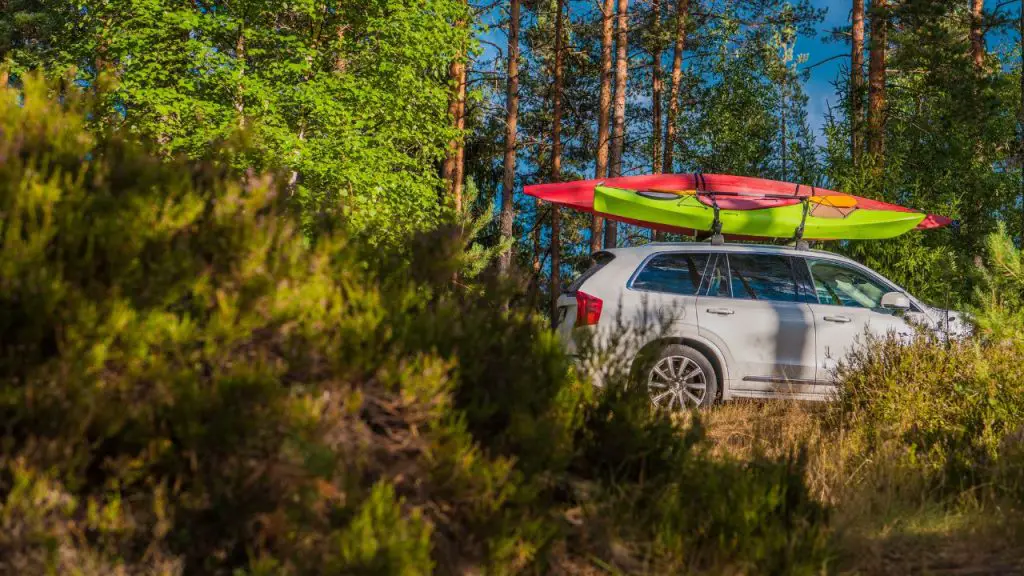
You can still transport your canoe to whatever destination you want without a roof rack. However, you need some items to secure it on your car. They include the following:
- Pool Noodles: These are readily available items in an outdoor store or a supermarket. If you don’t find them, you can use any polyurethane tube as a substitute. Ensure it has a hole in the middle. Choose thick, heavy-duty pool noodles that can extend the entire width of your car. This creates a soft bed for the canoe to rest on without scratching or exerting more pressure on the vehicle.
- Cam Buckle or Ratchet Straps: These are like the string you will use to secure the canoe on your vehicle. They are usually long and have adjustable buckles. Once placed around the canoe, you simply move it to tightly hold it on your car. Cam buckles or ratchet straps are available in hardware or automotive stores nearby. Ensure you buy more than two sets for this purpose.
- Waterproof Tarps: You also need these to cover your canoe. Tarps can protect your canoe against weather elements such as harmful radiation from the sun and rain.
How to Transport a Canoe Without a Roof Rack
You are all set to start securing your canoe on your car if you have the above items. Ensure you follow every step outlined below to do it right. Skipping or missing any detail can spell disaster when on the road.
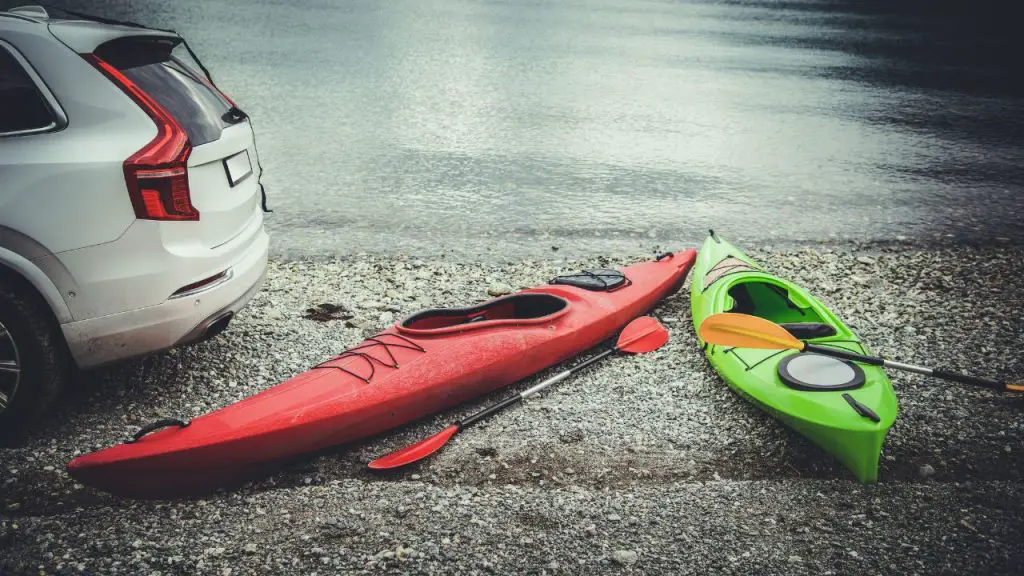
Step 1: Attach Pool Noodles to the Roof of Your Car
As mentioned, pool noodles protect your car from accidental abrasion by cushioning the canoe on top.
So, start by placing them on the roof of your vehicle. The pool noodles should be the correct shape for your car and placed every three feet.
The pool noodles you use will depend on your car’s roof size. Ensure there is at least one in the front, middle, and back.
Run one set of cam buckles or ratchet straps through the hole in the center pool noodles. Let it pass through the inside of the car. You should, of course, open the doors when doing that.
Step 2: Lift Your Canoe and Place it on top of the Pool Noodles
The next task is lifting your canoe or kayak from the ground. Most canoes are heavy and may require the effort of more than one person to safely carry from the ground. Find any help you may need before proceeding.
Turn the canoe upside down and let each person hold each end. Carefully lift and place it on the pool noodles secured on the roof. Ensure the midpoint of your canoe rests on the central pool noodle for perfect balancing.

Step 3: Tie down Canoe with Straps
Now that your canoe is safely resting on the top, it’s time to secure it using the cam buckles or ratchet straps. To do that, ensure all four doors of your car are open.
You can start securing the canoe on the car from the front or rear end. With the doors open, pass another set of ratchet straps over the rear of your canoe. Join them inside your car and adjust the ratchet to tightly secure the canoe.
Repeat the above process to secure the front side of the canoe. These two points are enough to hold it in place when in transit. But if you have more buckle straps, add one in the middle.
A pro tip when tightening the straps is to twist them. That will stop the annoying high-pitched howling sound that usually comes from untwisted ones when driving.
Also, ensure you can easily reach the buckles should you want to tighten the straps.
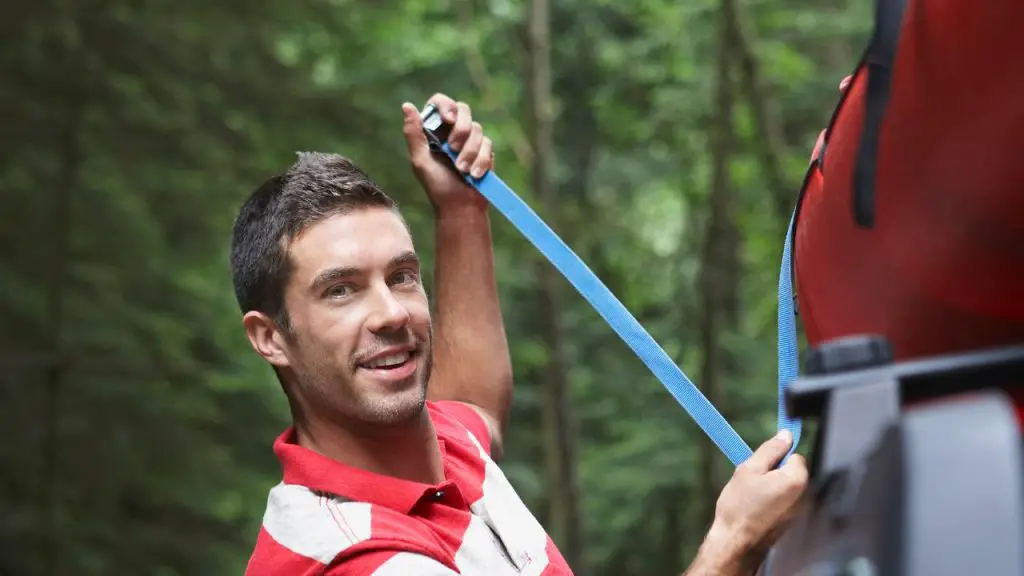
Step 4: Completely Secure Your Canoe and The Bow/Stern
Applying an emergency break can still send your canoe flying in front of the car. What you have done thus far is to prevent the side-to-side movement of the canoe on the roof.
It can, however, still move back and forth as you accelerate or brake.
To ensure that your canoe’s movement is restricted, pass another set of ram buckles or ratchet straps through the front carry handles of the canoe. Finally, tie them on the tie-down spots of your car using a securing hook or a carabiner.
Repeat the above steps on the rear side of your canoe. Viola! The hard work is done, and you are ready to hop onto the driver’s seat, or maybe not yet. Just one more step to go.
Step 5: Make Sure The Canoe Is Well Connected To The Car
Do one last check to ensure that the canoe is well secured on the car’s roof and that nothing can shake it off. Test it with your hands to confirm it is tightly resting on the pool noodles.
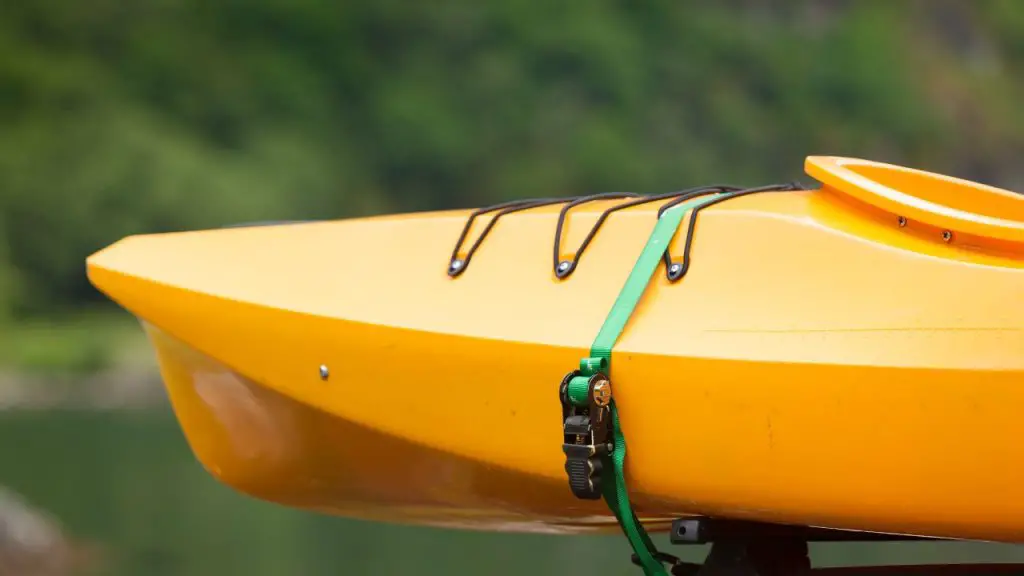
Safety Tips when Transport a Canoe without a Roof Rack
Transporting a canoe without a roof rack can be risky in many ways. And before doing it, ensure you take all necessary precautions. Consider using the following tips to avoid injuries and costly damages to your car:
- Use cam straps over ratchet straps if you can find them.
- Don’t over-tighten straps as it can damage the canoe.
- Double-check the canoe and all knots to ensure the canoe is safely secured on the roof of the car.
- Learn the basics of making a daisy-chain.
- Find out the weight-bearing capacity of your car’s roof and do not overload it.
- Do not place a canoe directly on the roof of your car. Place pool noodles, foam bricks, or cloths to prevent accidental abrasion.
- Do not let the straps pass directly above the driver’s seat because it will create distractions and discomfort.
- Never ever have a strap anywhere near your head driving.
Transporting a canoe without a roof rack is recommended for short trips and low speed. Consider investing in a decent roof rack if you plan on going long distances at highway speeds on interstates and highways.
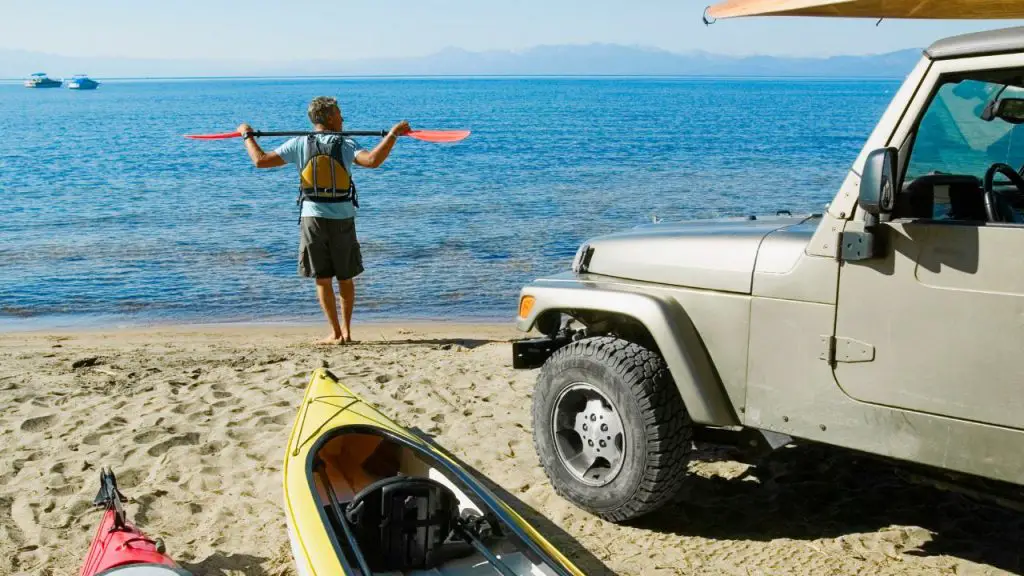
TMS® 2 Pairs J-Bar Rack HD Kayak Carrier Canoe
Transporting Canoes to the Water
Canoes are usually heavy for one person to carry. Find a companion to help you lift yours to the water. Even so, it is never a straightforward process.
Turn the canoe upside down to get enough grip. Most canoes have canoe thwarts designed to help you carry them on your shoulders or heads.
Moving your canoe to the water is a breeze if you have a canoe dolly or cart with wheels. You can move your canoe to any place you want with less effort.
FAQs
How do you haul a canoe in a short bed truck?
Start by running a cam buckle strap across the top of the canoe, parallel to the tailgate. Next, attach the buckle to the truck’s anchor point and make it tight by pulling it.
Now, run a second strap from the tow loop back to the bed anchor and pull the cam strap to get the canoe onto the truck bed.
How do you put a canoe on a car yourself?
You can put a canoe in your car by yourself. That, however, depends on the canoe’s weight and the height of your vehicle. It can be risky to do it yourself. So, care is needed. Follow this YouTube tutorial to learn how to do it.
How do you haul a canoe?
You can easily haul your canoe by loading it on a truck bed or roof rack. But if you have neither option, consider a foam-block system.
The foam blocks or pool noodles are placed on the car’s roof, and the canoe is carefully secured on them.
How do you transport a canoe on an SUV?
Some SUVs have roof racks where you can safely load and secure your canoe. But what if your SUV doesn’t have a traditional roof rack? Follow this video tutorial to learn how to transport a canoe without a roof rack.
How to transport 2 kayaks without a roof rack?
You can transport 2 kayaks or canoes without a roof rack. You only need pol noodles, ratchet straps, and stainless-steel poles. With everything ready, follow these steps to secure 2 kayaks on the car’s roof.
How to transport a kayak with a roof rack?
You can transport your kayak with a roof in just 10 steps. The first step involves buying foam blocks to protect the gunwales on the canoe.
Find details on transporting a kayak with a roof rack on Paddlingmag.
How to transport a canoe in a car?
Canes usually don’t fit in your car, even with seats folded. The only option is to load it on the roof or truck bed if you have a track. For the former, you will need a foam-block system to make it possible.
How to transport a kayak in a small car?
Even small cars can transport kayaks. You can use roof-mounted racks and a trailer or secure the kayak directly onto the roof of your vehicle.
Follow the steps outlined in this article to learn how to safely strap a kayak onto your car.
How to strap something to the roof of a car without a rack?
You don’t need a trailer or a roof rack to transport a canoe or any luggage in your car. You can use pool noodles or a soft cloth to prevent unnecessary abrasion and tie-down straps to secure the items onto the vehicle.
Anything can be strapped on the car, provided you don’t exceed the weight limit of your vehicle.
Conclusion
Transporting a canoe can be challenging if you don’t have a trailer and your car does not have a roof rack. Fortunately, you can still secure it on the roof using ratchet straps and pool noodles for cushioning.
Use the steps outlined in this article to achieve it. However, it should be for short-distance hauling and at low speeds.
Thank you for your time reading this article at Windpaddle. We appreciate your time and will be glad if you can share it with your friends. We also invite you to explore the website for related blog posts.



1 thought on “How to Transport a Canoe Without a Roof Rack”